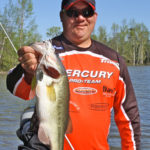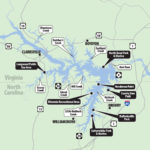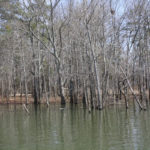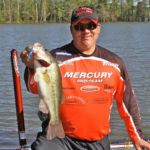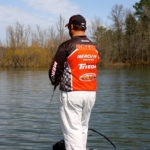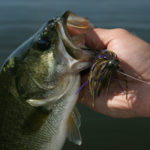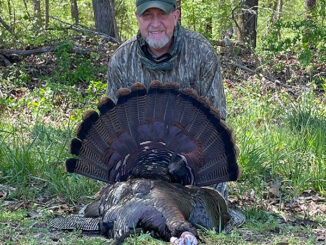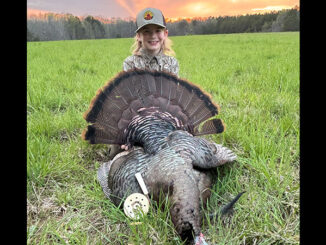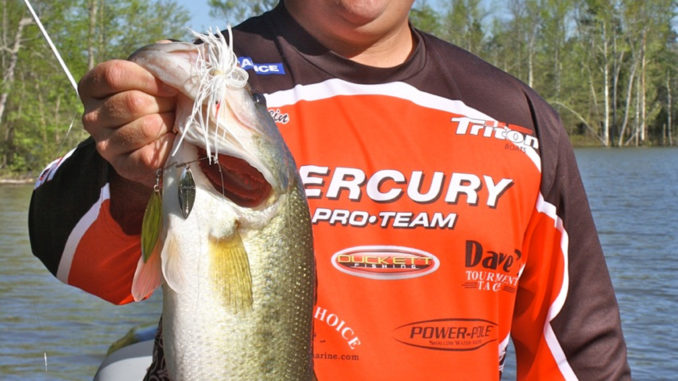
Lipless baits are important weapons when Kerr Lake bass start to move toward the shallows.
When the warm, afternoon sun warms the shallows to the 45- to 52-degree range, the underwater world at Kerr Lake, aka Buggs Island, becomes a stage for largemouth bass. They’ll start transitioning from their winter haunts to staging areas near their spawning grounds and stick around until warmer water triggers their instinct to spawn.
Fishermen can play a role in this unfolding drama if they locate these staging areas, which are typically in three to six feet of water when the water is at normal pool or below. Staging bass are often hungry bass, having recently been biologically awakened from their winter lethargy and fasting by changing weather, a definite plus for fishermen.
Tournament fisherman Tim Grein of Winston-Salem explains staging.
“Any time a bass comes out of its winter habitat to prepare itself for spawning, it comes to staging areas to feed, to fatten up for the spawning task ahead,” he said.
Anglers who take advantage of this movement have an opportunity to catch some of the biggest fish of the year. Timing the movement can be tricky if inconsistent weather patterns cause fish to stage at inconstant intervals.
Grein, who’s familiar with the staging process at Kerr and other Piedmont lakes, said the fish begin staging with the water temperatures in the lower 40s, though it’s not a major movement.
“If there’s a few days of warm weather and the water temperature rises three or four degrees, some fish might move up, but a cold front could push them back to their winter holes,” he said. “Extremes of weather can hasten or slow the movement. Fish stage in mass at Buggs and other lakes when the water temperatures is 52 degrees or more.”
Once staging begins in earnest, anglers locating those staging can fill a livewell in a hurry.
Grein said many of these spots are adjacent to spawning grounds, where the fish will make their next move. Typically, in the early spring at Kerr, staging occurs when the water is below full pool, out of the bushes and exposing shoreline cover.
When the fish make their initial move to stage, Grein targets clay banks on the north side of the lake that get plenty of exposure to the sun. Those banks not only hold heat, he said, but they’re the favorite hatching grounds for crawfish, which rank high on the list of dining treats for bass.
Grein also motors about the 50,000-acre reservoir, which straddles the North Carolina-Virginia border, looking for places that get a lot of sun at the north side. He keeps an electronic eye out for baitfish as well; if no baitfish are in an area, he won’t bother to wet a hook.
Likely staging areas on the huge impoundment include points, rocky corners and rock veins situated along the way to the backs of the major creeks.
Creek-channel edges near the backs of the creeks — if the channels are not filled with silt — also rank high as productive staging areas as well as flats in the creeks where there are signs of shad flashing along the bank. Most of these areas will involve northern shorelines, not necessarily the north part of the lake.
A treasured staging spot is white quartz rock.
“For some reason, bass gravitate to that rock, which is scarce at Buggs Island,” said Grein. “Most of the quartz rock is found in the Ivy Hill area.”
Grein said fishermen should visit the lake during winter drawdown to find potential staging spots because Kerr features a large piscatorial stage, with 850 miles of shoreline.
“You’ve got to do your homework,” Grein said. “You can’t expect to come to Buggs once a year and travel around a little bit and find these places; rocky corners, points, and veins aren’t just anywhere. You need to do a lot of riding with the water level … low enough to expose these places.”
At times, staging bass will school in large numbers on corners and flats. Grein said he once caught bass on a flat for three hours with a lipless crankbaits.
Once bass stage in good numbers, Grein said the fish are hesitant to move back out.
“A cold front may not push them out again or far from where they’re staging,” he said. “It takes a major weather change to make the fish move out again; they don’t want to go anywhere once they’re staging, but cold fronts can give them lockjaw.”
Grein looks for the warmest water available in the early spring, often found in the mid-lake area. The warm water prompts the staging process.
“Any water 50 degrees or above increases the likelihood of finding numbers of staging bass,” said Grein. “The water color isn’t that critical as long as it ranges from clear to stained and is warming up. Cold, dirty water is as bad as it gets and should be avoided. This situation is more of an issue at other lakes than it is at Buggs, because Buggs usually has large sections of clear water, even after heavy rains.”
In selecting baits for staging bass when the water is down, Grein favors shallow-running search and reaction baits.
Early in the staging process when the fish are still sluggish, he ties on a No. 5 Shad Rap, a Risto Rap or a Spro 50 or Little John MD, baits that can all be retrieved slowly for cold-water bass.
When the water warms and bass become more active and stage in good numbers, he likes lipless crankbaits for search baits because they can be retrieved quickly, he can cover a lot of territory and often trigger reaction strikes because bass can’t get a good look at the quick-moving baits but react to them as they move past.
Grein chooses 1/4-ounce lipless models for shallow fish and 1/2-ounce lipless models for fish deeper than three feet. At one time, Grien fished Rat-L-Traps “almost exclusively,” but under windy conditions, he’ll switch to a 5/8-ounce Yo-zuri Rattlin’ Vibe or an Xcalibur Rattle Bait.
“I use the Rat-L-Trap if there’s trash on the water or for a shallow bite, and the other models in windy conditions and for deeper fish,” said Grein. “They’re all about equal as fish catchers and excellent choices when the bass are feeding on shad.”
Color selection depends upon water clarity. In clear water, Grein said blue/chrome, black/chrome and other chrome finishes are good colors at Buggs Island In dingy water, crawdad-colored baits get the call.
To fish creek-channel edges, he uses medium-running crankbaits or slow-rolls spinnerbaits.
For cranking small lures and lipless crankbaits, Grein uses a 7-foot medium-heavy Pinnacle cranking rod and a Pinnacle Optimus Lite reel with a 5:5:1 gear ratio for slow-to-moderate retrieves.
“The rod has enough backbone to clear grass off the bait but still has enough tip so I don’t lose fish when they shake their heads,” Grein said. “The reel is spooled with 10- to 12-pound fluorocarbon line.”
One factor at Buggs that dramatically affects staging locations is high water. Rising water after heavy rains has been known to cover picnic tables and caress traffic signs along the lake’s swollen, wooded shorelines A cold rain could drop the water temperature as much as five degrees and impede staging.
“Even with rising water, the fish won’t move to the bushes immediately; they’ll stay suspended along the original shoreline,” Grein said. “The fish won’t move to the bushes until the lake level stabilizes.”
Keeping track of the water level helps fishermen know when the lake is stable, but even if an angler guesses correctly, bass scatter into the wooden cover along the shoreline when the waters gets into the bushes.
“The result is tough fishing,” said Grein. “There are buttonwood bushes and gum trees by the hundreds in any given stretch of water.”
The high water also influences the choice of baits.
When fish are suspended along the original shoreline, Grien uses white/chartreuse Hawg Caller spinnerbaits with double Colorado blades and Missile Twin Turbo plastic trailers.
“The double-Colorado blades pull more in the water and force me to make a slow retrieve,” said Grein.
When the fish move to the bushes, he uses jigs as light as 1/8-ounce. Why the lightweight jigs?
“Bass that stage in the bushes (on) high water often suspend in the bushes,” said Grein. “If you flip a heavy jig, the jig goes below them because they’re not at the bottom of the bushes. A light jig falls slowly and gives the fish time to react.”
Grein often tips his jigs with Missile Baby D Bomb or Craw plastic trailers, especially when he picks up a flipping stick, in his case, a 7-foot, heavy action Pinnacle rod and reel combo with a 7.3:1 gear ratio that helps moved hooked fish out of the heavy cover before they can wrap him up and escape.
As the spawn approaches, bass will move to the bottom of the bushes where they’re caught with 1/4- or 1/2-ounce jigs.
While bodies of water possess various cover and differ in geographical location, Grein said the staging process is similar at every lake because it’s dictated by water temperature.
The ideal conditions that prompt bass to stage are two or three days of weather in the 60s that push water temperatures into the lower 50s.
“Fishing can be lights out when that happens,” said Grein.
DESTINATION INFORMATION
HOW TO GET THERE — Kerr Lake (Buggs Island) straddles much of the North Carolina-Virginia line between South Boston, Va., and Henderson, N.C. Best roads to access the lake are I-85, US 58 and US 15. Popular public boat ramps include Satterwhite Point, Hibernia, Henderson Point, Bullocksville and County Line in North Carolina, plus North Bend near the dam and Longwood near Clarksville on the Virginia side.
WHEN TO GO — Bass begin staging in numbers when the water temperature reaches the lower 50s, usually sometime in March. Fishing for staging bass is best when the water level is below normal and the water is out of the shoreline bushes. Some of the biggest bass of the year move shallow at this time. High water puts staging bass in the shoreline cover where they are scattered and hard to find.
TECHNIQUES — Staging areas are adjacent to spawning grounds, including rocky corners and points, flats and creek channels toward the backs of creeks and clay banks exposed to the sun, and rock veins. Fish staging areas in three to six feet of water with shallow-running crankbaits, lipless crankbaits and spinnerbaits. When fish are in the bushes, flip jigs and soft-plastics around buck bushes, gum trees and shrubs.
GUIDES/FISHING INFO — Joel Richardson, www.joelgrichardson.com; Lynn Harvell Jr., Topwater Guide Service, 434-374-8914. bobcat’s Bait & Tackle, Clarksville, Va., 434-374-8381, www.kerrlake.com; U.S. Army Corps of Engineers (lake levels), 434-738-6371. Also see “Guides & Charters” section in this publication.
ACCOMMODATIONS — Coopers Landing, Clarksville, Va., 434-374-2866; Best Western on the Lake, Clarksville, Va., 877-564-2464; Lake Motel, Clarksville, Va., 434-374-5500. Econo Lodge, Henderson, 252-438-851; Hampton Inn, Henderson, 252-492-3007; Scottish Inns, Henderson, 252-438-6172.
MAPS — FHS Maps, 800-ALL-MAPS; GMCO Maps, www.gmcomaps.com, 888-420-6277.

